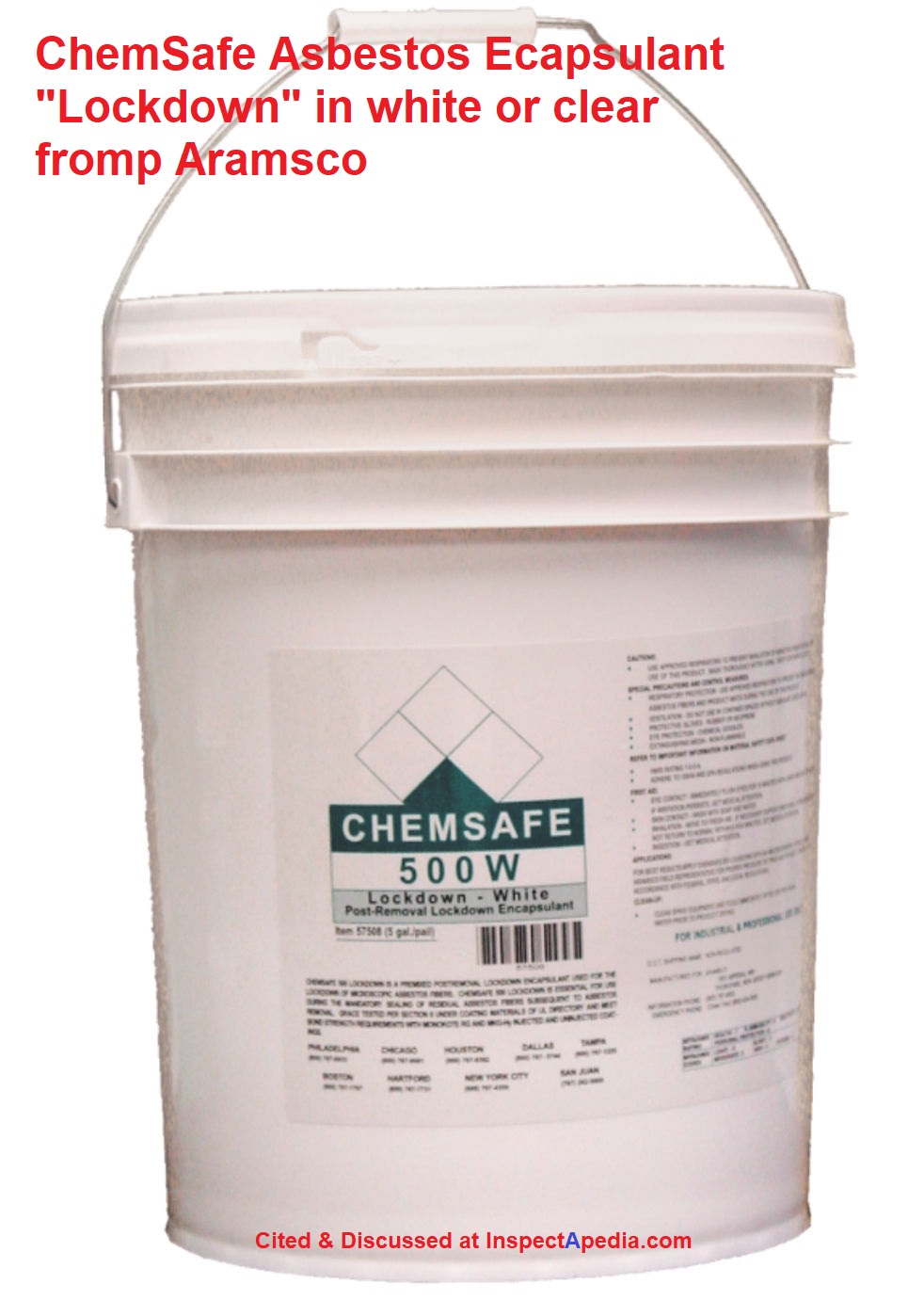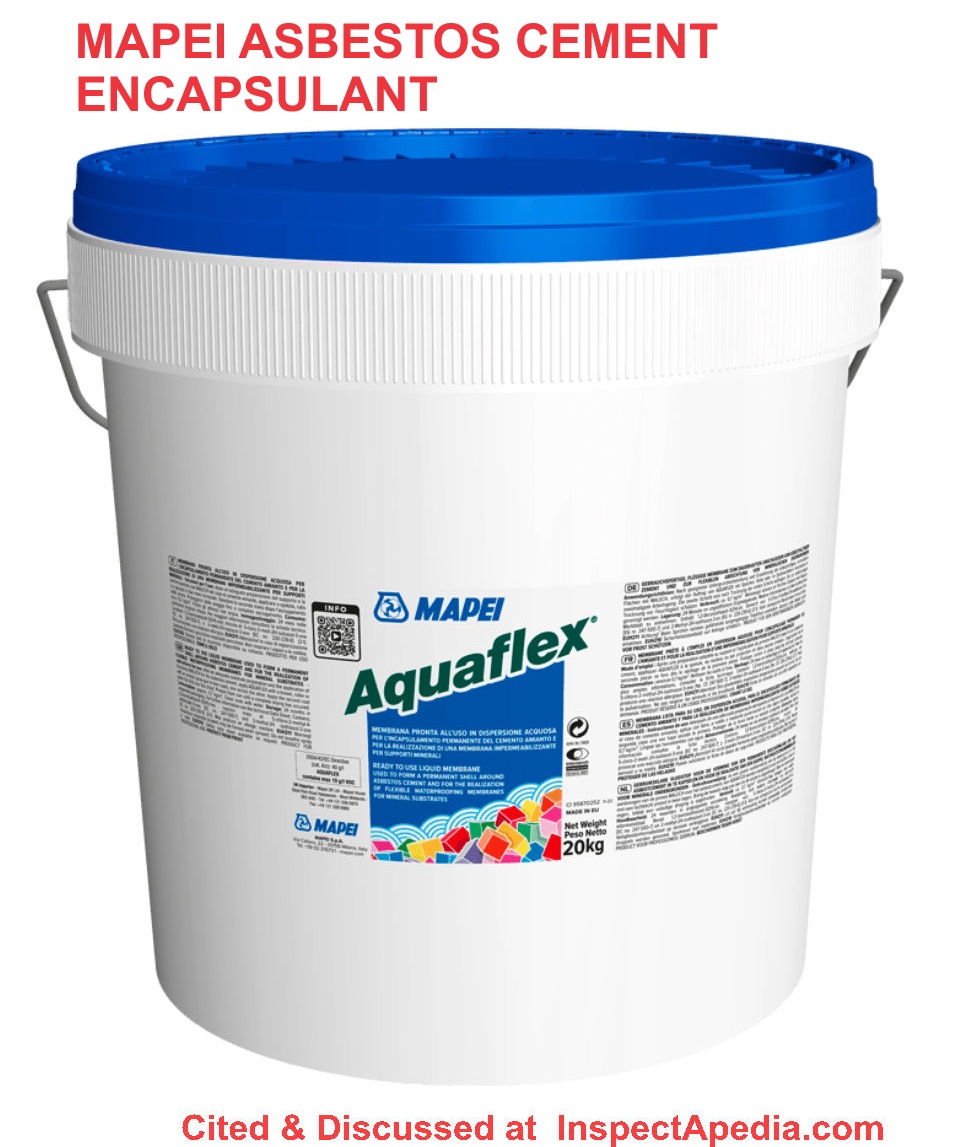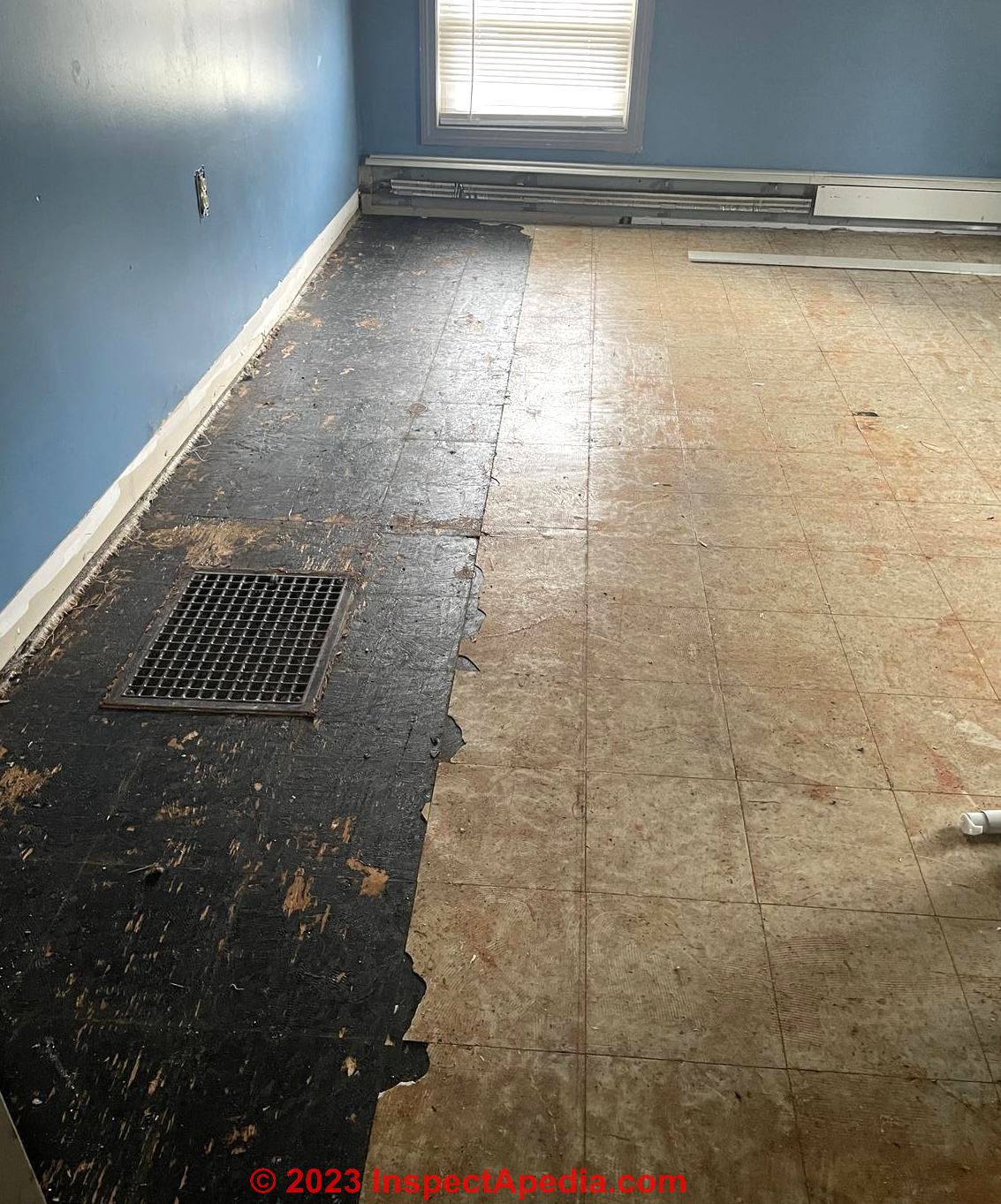 Asbestos Material Sealants & Coatings
Asbestos Material Sealants & Coatings
Asbestos-containing roof, wall, floor, or insulation encapsulants & paints
- POST a QUESTION or COMMENT about sealants, coatings, and lock-down sealers used to control release of asbestos particles, dust, fibers
This page lists sealant paints, sprays, knock-down & lock-down coatings suitable for asbestos insulation, asbestos lagging on boilers, spray-on asbestos fire insulation, asphalt or vinyl asbestos flooring or exposed asphalt-asbestos flooring mastic adhesive, and for cement asbestos or transite pipe products.
Page top photo: Fiberlock ABC Asbestos Binding Compound cited in the article below.
InspectAPedia tolerates no conflicts of interest. We have no relationship with advertisers, products, or services discussed at this website.
- Daniel Friedman, Publisher/Editor/Author - See WHO ARE WE?
Encapsulants, sealants, coatings used on Asbestos Containing Materials
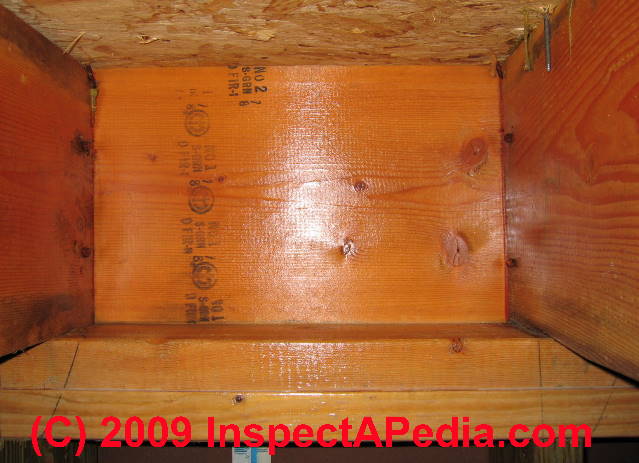 Here we list & describe products used to control or prevent the release of fibers, dust or particles from asbestos containing materials (ACM) such as asbestos pipe or boiler insulation, asbestos-cement products such as transite ducts, pipes, chimneys, and asbestos-containing flooring such as asphalt-asbestos or vinyl asbestos floor tiles or sheet flooring.
Here we list & describe products used to control or prevent the release of fibers, dust or particles from asbestos containing materials (ACM) such as asbestos pipe or boiler insulation, asbestos-cement products such as transite ducts, pipes, chimneys, and asbestos-containing flooring such as asphalt-asbestos or vinyl asbestos floor tiles or sheet flooring.
The list includes a range of ACM coatings and treatments such as sprays for sprayed-on asbestos fire insulation and sprays or coatings to lock down any remaining dust or fibers on and in a building following an asbestos removal or remediation project.
Some of these sealants and coatings are useful for dust and particle control beyond asbestos, such as in mold remediation projects or other general building clean-up projects following a fire or flood.
Photo above: Fosters 4051 clear sealant used on wood surfaces following an asbestos or mold remediation job.
Watch out: for any sealant or coating to be effective in both preventing future particle or asbestos release into building air AND where necessary, to bond with new layers of material such as adhesives for flooring or ceiling tiles or even a finish coat of paint, the surface to be sealed must be clean of loose debris and dry.
If you are planning to paint a floor covered with asbestos floor tiles using an epoxy paint, as described
at ASBESTOS FLOORING LEFT IN PLACE,
you'll also need to strip any waxes from the floor surface.
See STRIPPING a FLOOR BEFORE SEALING
Sealant Paints & Coatings for Asbestos Containing Materials: Sources, Instructions
- Aramsco,
ChemSafe, Asbestos Encapsulant, 500W Lockdown, Clear or White, Catalog No. 7539, Aramsco, Inc.
1480 Grandview Ave.
Paulsboro, NJ 08066
USA, Tel: 800.767.6933, website: https://www.aramsco.com/ Email: customer.service@aramsco.com
Website excerpt:
Chemsafe lockdown is a post removal lockdown encapsulant solution provided premixed for your convenience chemsafe lockdown is an encapsulant which provides for the lockdown of microscopic asbestos fibers to the substrate via the forming of a flexible resinous barrier.
This flexible barrier also serves a dual purpose by priming the substrate and allowing for the adhesion of secondary coatings. Essential for use during the mandatory sealing of microscopic asbestos fibers subsequent to asbestos removal Acceptable for use as a penetrating encapsulant as provided - Australia: "SEALING, PAINTING, COATING AND CLEANING OF ASBESTOS CEMENT PRODUCTS" [PDF], Victoria Government, Australia, retrieved 2019/08/28 original source: http://www.asbestos.vic.gov.au/in-the-workplace/sealing-painting-coating-and-cleaning-asbestos-cement-products
- Australia: SAFE PRACTICES for HOMEOWNERS REPAIRING or REMOVING SMALL AMOUNTS of ASBESTOS MATERIALS [PDF] retrieved 2019/08/28 original source: https://asbestosawareness.com.au/wp-content/uploads/2016/11/Fact-Sheet-2-Detailed-Asbestos-Management-1.pdf
- Australia: SAFE CUTTING HANDLING REMOVAL of TRANSITE PIPE [PDF] retrieved 2019/08/28 original source: https://www.qldwater.com.au/_literature_232979/Asbestos_Cement_Pipe_Cutting_Guidelines_June_2014
- Australia: ASBESTOS GUIDE for MINOR RENOVATION [PDF] Queensland Government, Australia, retrieved 2019/08/28 original source: https://www.bundaberg.qld.gov.au/files/document19919.pdf
- Canada IHSA, ASBESTOS ADVICE [PDF] health and safety advice, retrieved 2019/08/28 original source https://www.ihsa.ca/rtf/health_safety_manual/pdfs/hazards/Asbestos.pdf
Excerpts:
If you have any concerns about material that you believe may be asbestos, have it checked before work is started. Otherwise, treat the material as if it is asbestos. Asbestos is a "designated substance" under Ontario health and safety legislation. This means that its exposure is prohibited, regulated, restricted, limited, or controlled.
Owners must notify contractors of the presence of any designated substances on a project before work begins or tenders are submitted. Contractors also have a responsibility to advise subcontractors. IHSA has developed a guide for creating this notification report. Owner’s Duties: Designated Substances on Construction Projects (W130) is available to download for free from our website. - EPA MANAGING ASBESTOS in PLACE: A BUILDING OWNER'S GUIDE TO OPERATIONS AND MAINTENANCE PROGRAMS FOR ASBESTOS-CONTAINING MATERIALS ("Green Book"), web search 08/11/2010, original source: http://www.epa.gov/asbestos/pubs/management_in_place.html
How to Develop and Maintain a Building Asbestos Operations and Maintenance (O&M) Program, This information is designed to assist building owners and managers in understanding how to develop and maintain an operations and maintenance program for asbestos-containing materials in their buildings. - EPA Guidance for Controlling Asbestos-Containing Materials in buildings, NIAST, National Institute on Abatement Sciences & Technology, [republishing EPA public documents] 1985 ed., Exposure Evaluation Division, Office of Toxic Substances, Office of Pesticides and Toxic Substances, U.S. Environmental Protection Agency, Washington,D.C. 20460
 Illustration: Fiberlock ABC Asbestos Binding Compound - Clear Encapsulant, sold widely. Product description excerpted from norkan.com a Fiberlock product distributor.
Illustration: Fiberlock ABC Asbestos Binding Compound - Clear Encapsulant, sold widely. Product description excerpted from norkan.com a Fiberlock product distributor.
ABC Asbestos Binding Compound, our flagship product, is the world's most successful encapsulation solution. This highly effective, industry-standard, high-solids encapsulant meets Environmental Protection Agency guidelines.
It's ideal for sealing in asbestos-containing material, as laboratory tests have shown. The EPA recommends you apply two coats for maximum effectiveness.
... The high solids, nonflammable composition of A-B-C allows for dilution with water to provide maximum flexibility for specific asbestos abatement needs, including removal/lockdown, penetrating encapsulation and bridging encapsulation.
Since 1978, A-B-C has provided exceptional long lasting performance in asbestos abatement worldwide.
- Fiberlock A-B-C Asbestos Binding Compound (sold in 5 gallon pails)
- Fiberlock A-B-C Fiberspray encapsulant (sold in CFC-free spray cans)
- Fiberlock ABC Bridging Encapsulant, intended for coating spray-on fireproofing insulation in buildings - sold in pigmented and clear (6422) versions
- Fiberset PM, pre-mixed "lockdown" sealant used to seal surfaces after removing asbestos-containing materials
- Fiberlock Grip-Tack, high-solids water-based lockdown/adhesive used to coat surfaces before, during and after removal of asbestos-containing materials
- Fiberlock Penwet, colorless surfactant penetrantes and seals asbestos-containing material (ACM) to aid in removal with reduced particle release
- Fiberlock Lag Kloth, water-activated repair cloth to repair or cover existing asbestos-insulated pipes, boilers, etc.
- Fiberlock Lag Kote (Exterior) white acrylic encapsulant/sealant paint formulated for use on asbestos-containing materials (ACM) and rated for exterior use, may be particularly suited for use on transite pipes; includes UV inhibitors.
- Fiberlock Lag-Kote II, thicker than the Lag Kote Exterior product cited above) flexible coating that can be applied over metal, wood, masonry, other sound surfaces, to seal against release of asbestos particles. This coating is particularly suited for friable asbestos materials to use as an encapsulant
- Fiberlock Lag Kwik water-activated repair cloth used to repair areas of damage on asbestos-insulated pipes, boilers, etc. To be top coated with other Fiberlock sealant
- Lag Kloth is a fabric impregnated with adhesive used to wrap asbestos insulated pipes in buildings, sold as a roll, blanket, or tape
- Fiberlock PM UL-classified "Lockdown" clear encapsulant 7475 spray coating sealant used after asbestos removal
- Fiberlock SERPIFLEX ASBESTOS ENCAPSULANT [PDF]
Website except: SerpiFlex Asbestos Encapsulant is a concentrated water-based vinyl acrylic product with various flameretardant chemicals and fillers. It is nontoxic, non-combustible and does not contain any solvents or silicates. Available in clear, white and colors. - Fiberlock TBC Transite Barrier Compound "a white, elastomeric thermoplastic water based copolymer, blended specifically to seal exterior asbestos containing Industrial Fiber Cement Board (Transite®).
TBC is a high solids blend of resins that forms a hard yet flexible finish which is ultraviolet resistant and mildew resistant. " [Sic. Actually there is no mildew in buildings; mildew only grows on living plants; if it's on a building surface it's mold but it's not mildew - Ed.] - Fiberlock Wet-Wrap 'N' Seal is a warp used to seal asbestos-insulation on building surfaces and pipes
- First Place Supply, 47 N. Treaty Hwy Pocatello, ID 83202 USA Tel 866-523-7168 Web: https://www.firstplacesupply.com
- Hong Kong EPD ACM IDENTIFICATION & ABATEMENT LIBRARY [PDF] retrieved 2019/08/28 original source: https://www.epd.gov.hk/epd/sites/default/files/epd/english/environmentinhk/air/asbestos/files/ACMLibrary_Book1.pdf
- Mapei Aquaflex System, [illustrated above] MAPEI Americas Headquarters
1144 E. Newport Center Drive
Deerfield Beach, Florida 33442 USA, Technical Service: 1-800-992-6273 (U.S. and Puerto Rico) or 1-800-361-9309 (Canada).
For help with locating a distributor of MAPEI products, call Customer Service at 1-800-426-2734 (1-800-42-MAPEI).
Described at https://www.mapei.com/it/en/products-and-solutions/products/detail/aquaflex-system
Thanks to InspectApedia reader Mr.Precision for this suggestions - 2024/02/11
Product Description Excerpts:
Permanent encapsulation of asbestos cement.
Use Aquaflex System cycle for the permanent encapsulation of type A (external view), B (internal view) and C (no view, before confinement) in compliance with the August 20, 1999 Italian Ministerial Decree, of asbestos cement structures exposed to atmospheric agents, therefore subject to progressive degradation, with emerging and release of asbestos fibre.
The system is made up of two products of certified quality by authorised laboratories:
- Malech: micronized acrylic resin-based primer in water dispersion that, thanks to its high wetting capacity, penetrates into deteriorated material and binds the fibres to each other and to the cementitious matrix to prevent them from being released into the atmosphere. It also creates a surface for the next layer in the encapsulation system to anchor to.
- Aquaflex: it is a one-component elastomeric resin, in water dispersion based encapsulating coating. As prescribed by August 20, 1999 Ministerial Decree, the product must be applied in two contrasting coloured coats, because over time the appearance of the colour of the first coat indicates the need to carry out a new encapsulation cycle. - Mapei PRIMER T [PDF] MAPEI Americas Headquarters
1144 E. Newport Center Drive
Deerfield Beach, Florida 33442 USA, Technical Service: 1-800-992-6273 (U.S. and Puerto Rico) or 1-800-361-9309 (Canada).
For help with locating a distributor of MAPEI products, call Customer Service at 1-800-426-2734 (1-800-42-MAPEI).
Website Excerpts: Use Primer T when applying a self-leveling underlayment on properly prepared suitable substrates.
Primer T is a low-VOC, magenta-colored, water-based acrylic primer that enhances the performance and adhesion of self-leveling underlayments (SLUs) on nonporous and porous substrates. Suitable for a wide variety of substrates, Primer T combines excellent versatility with easy, low-odor application. - Metro Supply Co., Tel: 973-478-1970 (NY) or 718-383-0117 (NJ) in the U.S., Website: http://metrosupplycollc.com Email: sales@metrosupplycompany.com
(This is a US company but their webstie gives no mailing or street address - Ed.) - Norkran Asbestos Encapsulation Products, 25200 Easy St., Warren MI 48089 USA, Website: https://www.norkan.com/asbestos-encapsulation.php Tel: 800-227-8479 Email: sales@norkan.com
Includes also residential paint and epoxy floor coatings
Above: PerfectPrimer® from Specialty Solutions Co. The company says that you can paint this primer over asphalt tile mastic and that it will then accept new flooring overlay.
- PerfectPrimer, Specialty Solutions Manufacturing, Inc., 119 South 3d St New Hyde Park, NY 11040
USA Tel: 718 736 8477
Web: PerfectPrimer.com
Email: info@perfectprimer.com
This sealant is marketed as safe for use over asbestos tiles, concrete, and mastics and is described by the company as an asbestos encapsulant.
Website excerpt: PerfectPrimer® is a complete floor prep system and universal primer/sealer. It forms a powerful molecular bond between nearly every coating or modified cement, with any clean, sound substrate including: wood, cut-back glue, sealed concrete, metal, roofing materials, ceramic tile, VCT, epoxies, masonry, and linoleum.
The company provides these and other helpful guides:
PerfectPrimer® for ASBESTOS ENCAPSULATION & OVER MASTICS [PDF] retrieved 2019/11/10 original source: op. cit.
PerfectPrimer® APPLICATION GUIDE [PDF] retrieved 2019/11/10 original source: op. cit.
Watch out: according to the company's primer selection chart, PerfectPrimer will bond to most coatings and virtually any surface, but it is not designed for use on un-coated concrete nor below-grade nor on rusty surfaces. Contact the company directly for product selection advice. - Specialty Solutions Co., Perfect Primer® floor prep primer/sealer. Specialty Solutions Manufacturing, Inc
119 South 3d St New Hyde Park, NY 11040
Tel: 718 736 8477
Fax: 516 750-9781
web: PerfectPrimer.com
E mail: info@perfectprimer.com Website: https://www.perfectprimer.com/product/perfect-primer-retail/
Website excerpt: PerfectPrimer® is a complete floor prep system and universal primer/sealer. It forms a powerful molecular bond between nearly every coating or modified cement, with any clean, sound substrate including: wood, cut-back glue, sealed concrete, metal, roofing materials, ceramic tile, VCT, epoxies, masonry, and linoleum. - UK: Rawlins Paints, "Asbestos Roof Paint", Rawlins Paints
Northspeed House
LS11 9NF Leeds
United Kingdom Tel: 0113 2455450 Email: sales@rawlinspaints.com
includes coatings for asbestos cement roofing and corrugated cement asbestos sheets or panels,
Website excerpt:
Corrugated asbestos roofing, asbestos cement and asbestos sheeting require specialist coatings to seal, repair and protect large surface areas. Rawlins Paints offer a wide selection of solvent and water-based rubber sealants and protective coatings for industrial properties, factories and commercial buildings.
To help you get the right asbestos paint or sealant coating for the job, please refer to product data-sheets, or contact our technical support team, who'll be happy to assess your situation and provide recommendations for single or compatible combination products for roofing.
Asbestos roofing should not be left un-coated or unprotected, and in sealing the fibrous cement sheeting, these asbestos compatible paints and coatings will prevent water damage, or water seeping through to the underlying substrates and building architecture.
Areas around asbestos sheets, such a roof tiles, flashings, box gutters, service ducts, outlet pipes, and areas which require a flexible coating, can also be protected and repaired using specialist paints and associated waterproofing products.
Readers and product suppliers are welcome CONTACT US by email to suggest additional products to this list and to provide technical literature on product use and effectiveness.
In order to absolutely assure our readers that we write and report without bias we do not sell any products nor services, nor do we have any business or financial relationships that could create such conflicts of interest.
InspectAPedia is an independent publisher of building, environmental, and forensic inspection, diagnosis, and repair information for the public - we have no business nor financial connection with any manufacturer or service provider discussed at our website.
...
Reader Comments, Questions & Answers About The Article Above
Below you will find questions and answers previously posted on this page at its page bottom reader comment box.
Reader Q&A - also see RECOMMENDED ARTICLES & FAQs
On 2023-02-04 by Paul - What do I use to seal black mastic left after removing old floor tiles?
Hello. What product is recommended to seal a black mastic that was under the old vinyl tile.
Also, do I need to seal entire surface of the room or just the black mastic?
On 2023-02-04 by InspectApedia Publisher
@Paul,
Using the on-page InspectApedia search box found above and at the top of each of our pages, a quick search for
"asbestos encapsulant paint" or "asbestos sealant" finds our best advice in answering your question - better than an off-the-cuff reply here:
please see
ASBESTOS ENCAPSULANTS & SEALERS (this is the page you are now on)
and let me know if, after reading that, there's more that we should add or clarify.
Eventually we will also move your question and our reply to that same article so that it may help other readers on this topic.
Do I need to seal an outdoor asbestos pipe?
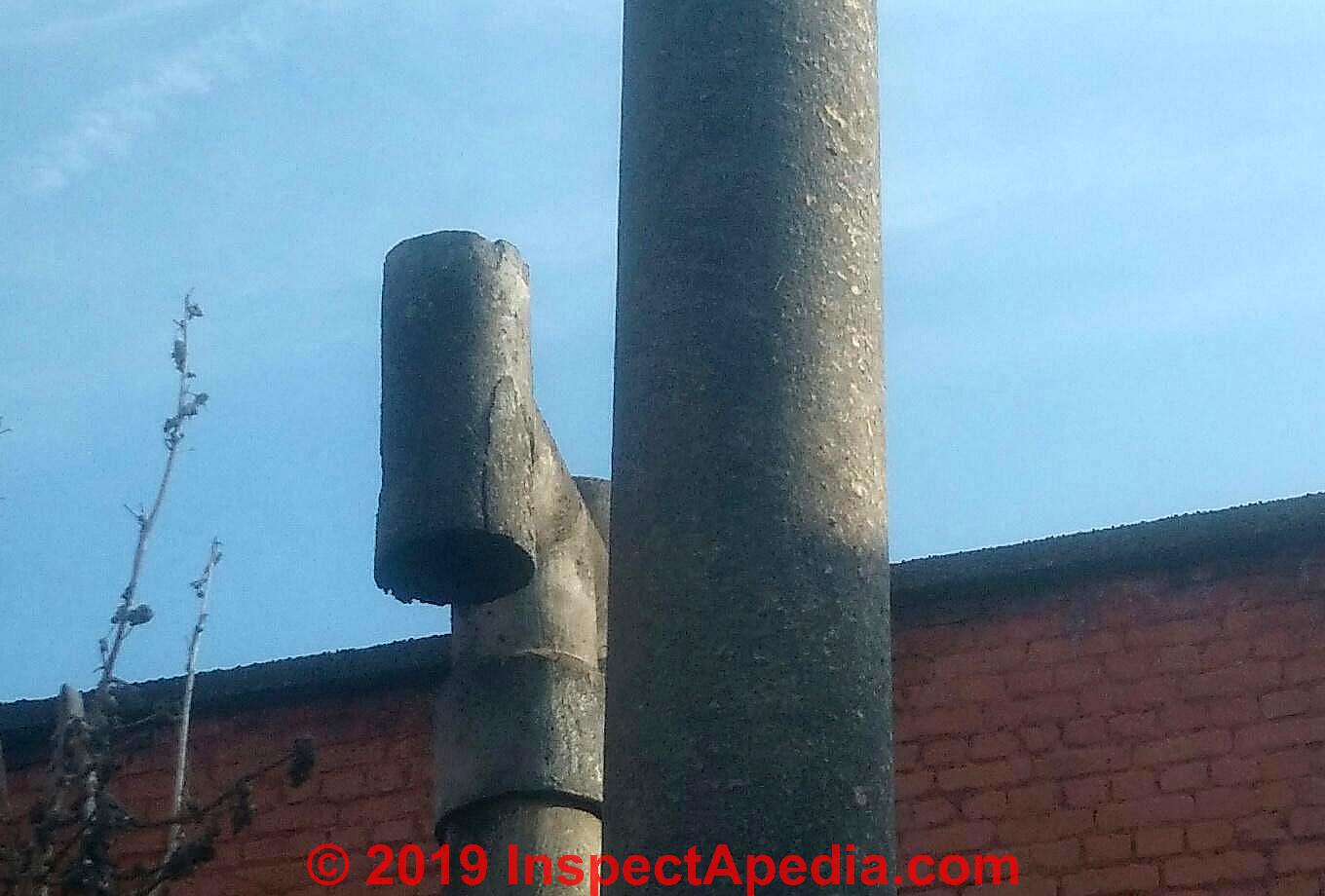 Hello, is there any danger if there is an asbestos pipe outdoors, around 2 metres away from the window or in the terrace of an apartment?
Hello, is there any danger if there is an asbestos pipe outdoors, around 2 metres away from the window or in the terrace of an apartment?
I show you some pictures. There are 2 long pipes, from the neighbouring building, and they show some wear. This is in the last floor of a 3 stories building, and it is outdoors. Would it be enough to just never open that window and never use the terrace? Or can they be used safely?
I might rent this appartment. Should I better not rent it? I am worried that some asbestos might come in through the window. - On 2019-08-28 by Daniel
This Q&A were posted at and are discussed in more detail
Reply by (mod) - paint or seal transite cement asbestos pipe in poor condition and in traffic areas
Daniel
With the reclama that nobody can make a risk assessment for environmental exposure to hazardous materials simply from a brief e-text and some photos, I see what looks like transite - asbestos-cement pipe in some of your images and in some spots the material is deteriorating, flaking, or delaminating.
It's not likely that, left un-disturbed, there would be much airborne asbestos from a cement-asbestos product unless it's being demolished, chopped, sawn, ground, etc. but there can be ground-level hazards from accumulated cement-asbestos dust
See ASBESTOS ROOFING / SIDING POWER WASHING for an example of that concern.
It might make sense to at the very least seal the exterior of the transite pipe flue (or whatever it's being used-for) where it's located in a traffic area such as at a deck.Reader follow-up:
The Fiberlock product that was suggested to me is Fiberlock ABC Asbestos Binding Compound. I'm not sure how it compares to PerfectPrimer. I've seen a video of the latter product and it shows a workman painting right over black mastic. That's what remains on my concrete floor where the loose tiles were removed.
I'm very aware of your warning that for effective bonding to take place the floor needs to free from dust, debris, and a variety of other things. I'm trying to figure out how to clean my floor without exposing myself to asbestos fibers.
I'm looking at using a P100 mask. That will mean shaving my beard for maximum effectiveness. I thought of buying a HEPA vac but I've read that the debris should be wetted down and removed without using a vacuum. There is also the issue of what to use to fill the spaces left by the missing tiles. If new tiles are used there might be a bonding issue with the primer/sealer.
Reply:
You may have already applied a Fiberlock™ sealant but on thinking about this further it occurs to me that if you intend to install new vinyl floor tiles there is probably no need to first apply a sealant at all.
You'd simply use an adhesive mastic that's compatible with the remaining black asphaltic mastic already in place and glue tiles right over it.
While there's often asbestos in the mastic adhesive, it's not friable. One would simply clean the surface of all loose debris, perhaps damp wiping, and when dry, adhere the new floor over the old mastic.
That would avoid the worry of needing a very good double bond of Fiberlock to old mastic and new floor tile adhesive to the Fiberlock.
Do keep me updated on how this project goes.
On 2020-10-27 by George - Rather than hire an asbestos abatement company I did it myself
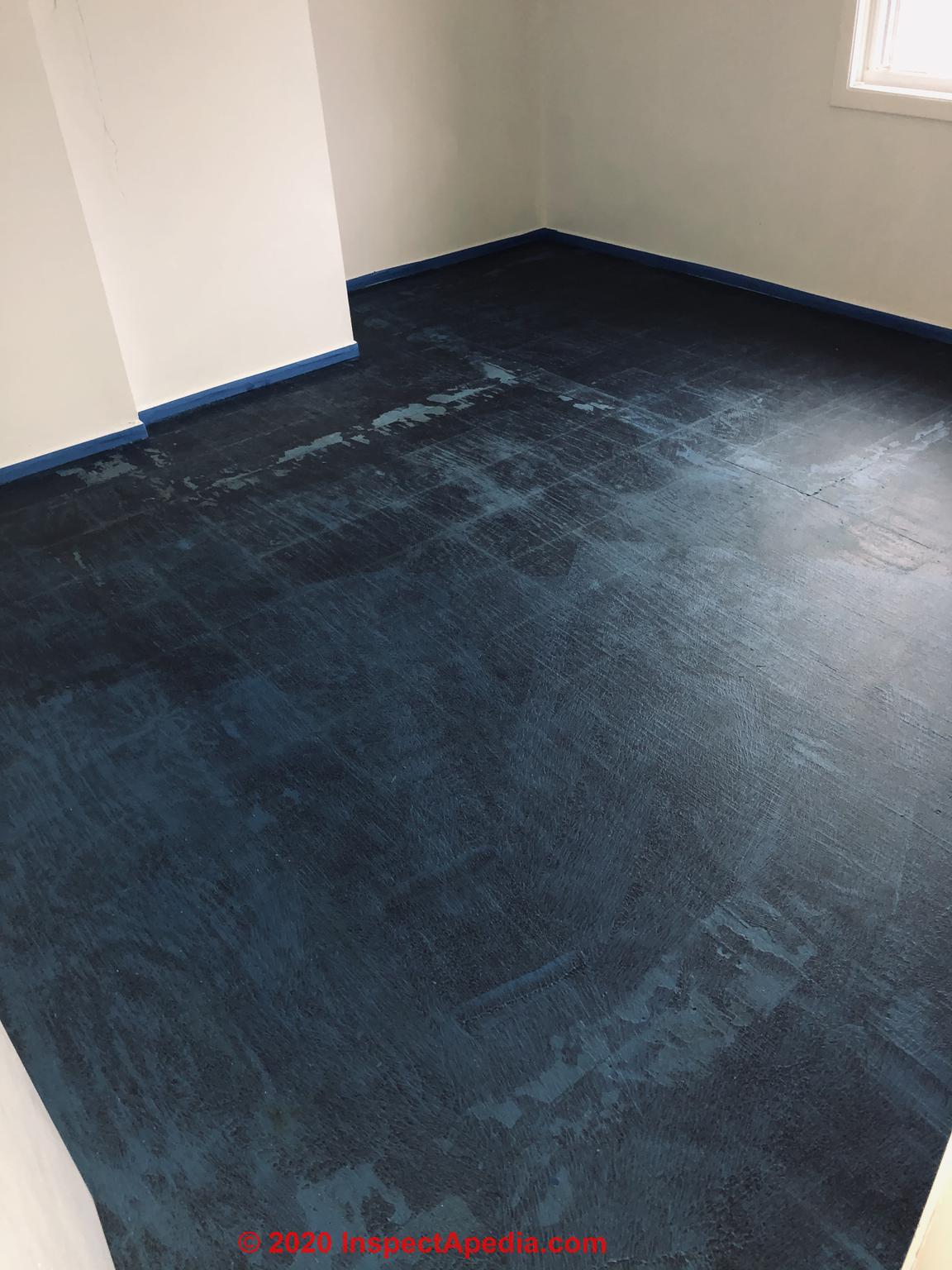 I have a small 10’ x 12’ room that had 9” x 9” asbestos tiles. I had the tiles and mastic tested at a lab. Results came back 1-3% Chrysotile, 0% Amosite in the black mastic, and 2-3% Chrysotile, 0% Amosite in the tile.
I have a small 10’ x 12’ room that had 9” x 9” asbestos tiles. I had the tiles and mastic tested at a lab. Results came back 1-3% Chrysotile, 0% Amosite in the black mastic, and 2-3% Chrysotile, 0% Amosite in the tile.
Rather than hire an abatement company I did it myself, and perhaps took more precautionary measures than necessary due to it being only Chrysotile, and a low percentage at that with a short exposure time.
I sealed the entry door and air duct vent in the room with plastic, used a hazmat suit rated for asbestos work, wore a full face respirator with P100 filters, and opened the window (left open for 2 days).
Most of the tiles came up very easily, and some tiles were quite friable, as they crumbled fairly easily.
As I removed the tiles, I sprayed some of the smaller/crumbly pieces down with a water/dish soap solution to prevent dust, but it still got a little dusty in there. I then bagged up all the tiles and placed them in a garbage bin outside of the room's open window.
What was left was black mastic on a wood sub-floor. I put MBP Multi-Surface Bonding Primer (from Home Depot) over the mastic floor (see attached picture). I realized after the fact that I should've used "Perfect primer", but it's too late. The MBP primer after drying has a rough gritty texture to it. The product is actually intended for creating adhesion to ceramic tiles or other cement-based flooring.
To my question...
I want to clarify what I read above on this page that: I can put floating Vinyl Plank Flooring over the wood floor that has the black mastic over it. Will this provide adequate protection from the mastic underneath? I will also be putting a layer of interlocking gym padding over the vinyl planks so that we may use the room as a home gym.
Here is a link to a white paper and the most informative document I have found regarding health risks from different types of asbestos, particularly, Chrysotile:
sibility of those particles moving up into the occupied space.
Add to that that mastic, an asphaltic coating that contained asbestos fibres, is not normally friable.
- Bernstein, David, Jacques Dunnigan, Thomas Hesterberg, Robert Brown, Juan Antonio Legaspi Velasco, Raúl Barrera, John Hoskins, and Allen Gibbs.
HEALTH RISK OF CHRYSOTILE REVISITED [PDF] Critical reviews in toxicology 43, no. 2 (2013): 154-183.
Abstract:
This review provides a basis for substantiating both kinetically and pathologically the differences between chrysotile and amphibole asbestos.
Chrysotile, which is rapidly attacked by the acid environment of the macrophage, falls apart in the lung into short fibers and particles, while the amphibole asbestos persist creating a response to the fibrous structure of this mineral.
Inhalation toxicity studies of chrysotile at non-lung overload conditions demonstrate that the long (>20 µm) fibers are rapidly cleared from the lung, are not translocated to the pleural cavity and do not initiate fibrogenic response. In contrast, long amphibole asbestos fibers persist, are quickly (within 7 d) translocated to the pleural cavity and result in interstitial fibrosis and pleural inflammation.
Quantitative reviews of epidemiological studies of mineral fibers have determined the potency of chrysotile and amphibole asbestos for causing lung cancer and mesothelioma in relation to fiber type and have also differentiated between these two minerals.
These studies have been reviewed in light of the frequent use of amphibole asbestos. As with other respirable particulates, there is evidence that heavy and prolonged exposure to chrysotile can produce lung cancer. The importance of the present and other similar reviews is that the studies they report show that low exposures to chrysotile do not present a detectable risk to health.
Since total dose over time decides the likelihood of disease occurrence and progression, they also suggest that the risk of an adverse outcome may be low with even high exposures experienced over a short duration.
Keywords: Amphibole asbestos, cement products, chrysotile, epidemiology, health risk, inhalation toxicology, mining
Thank you for any info you may have regarding my question / concern.
On 2020-10-27 by (mod) - sealants & new flooring layer over asbestos-suspect flooring mastic adhesive - DIY Asbestos abatement, Chrysotile hazards?
George
In my opinion, any covering flooring that is continuous and secure ought to minimize the risk of remaining mastic on your floor, especially if under the engineered flooring you describe you've already got a layer of primer.
Nobody can know for a fact what an un-built anything is going to do, but in general, in my OPINION, the combination of covering the remaining mastic with primer and then with an interlocking plank flooring means that there ought to be minimal movement to disturb the mastic and even less possible.About the Bernstein Article you cited,
Really? We have provided a copy of the Bernstein et als article, above as a PDF download; See also the following comments that are quite critical of the article above and its conclusions - Ed.
- Bernstein, David, Jacques Dunnigan, Thomas Hesterberg, Robert Brown, Juan Antonio Legaspi Velasco, Raul Barrerao, John Hoskins, and Allen Gibbs.
"RESPONSE to Murray M. Finkelstein, letter to the editor re Bernstein et al: Health risk of chrysotile revisited. Crit Rev Toxicol, 2013; 43 (2): 154–183." Critical reviews in toxicology 43, no. 8 (2013): 709-710.
Excerpts:
Surprisingly, Bernstein and colleagues completely ignored the human lung burden studies that refute their conclusion about the short biopersistence of chrysotile.
[the authors then cite numerous works offering a different conclusion than Bernstein et als and conclude as follows:]
The human data concerning chrysotile retention in occupationally exposed populations are thus inconsistent with the statement of Bernstein and colleagues that chrysotile has a short biopersistence, yet Bernstein and colleagues completely failed to mention these data.
The Instructions for Authors planning to submit to Critical Reviews in Toxicology state that “Critical Reviews in Toxicology provides up-to-date, objective analyses of topics related to the mechanisms of action, responses, and assessment of health risks due to toxicant exposure.
The journal publishes critical, comprehensive reviews of research findings in toxicology and the application of toxicological information in assessing human health hazards and risks”.
By failing to mention any of the data which contradict their conclusions, Bernstein and colleagues have clearly not provided an objective analysis, and have created the impression that they have published a document to support the interests of the International Chrysotile Association, which, in cooperation with The Canadian Chrysotile Association, funded their work.
Really? and critical of the criticism:
- Bernstein, David, Jacques Dunnigan, Thomas Hesterberg, Robert Brown, Juan Antonio Legaspi Velasco, Raul Barrerao, John Hoskins, and Allen Gibbs. "Response to Murray M. Finkelstein, letter to the editor re Bernstein et al: Health risk of chrysotile revisited. Crit Rev Toxicol, 2013; 43 (2): 154–183." Critical reviews in toxicology 43, no. 8 (2013): 709-710.
Excerpt:
However, the data cited by Finkelstein do not contradict the concepts put forward by Bernstein et al. and in fact they appear in company with an understanding of the toxicology to clearly support these concepts.
Finally, Finkelstein refers to the funding of the Bernstein et al. review by the Canadian Chrysotile Association, stating that “they have published a document to support the interests of the International Chrysotile Association”.
In his own Declaration of Interest, Finkelstein declares that “The author has appeared as an expert witness in litigation concerned with alleged health effects of exposure to chrysotile”.
What Finkelstein has left unstated is the frequency with which he works for the plaintiff’s lawyers who would benefit from publication of his Letter to the Editor.
Declaration of interest
The preparation of the original paper was supported by a fixed sum grant from the International Chrysotile Association, Washington, DC, USA, in cooperation with The Canadian Chrysotile Association, Montréal, QC, Canada.
The affiliation of the authors includes university, government institute, hospital and corporate affiliations as well as independent toxicology consultants. This letter is the professional work product of the authors alone and may not necessarily represent the views of the corporate sponsors.
Two of the authors, David Bernstein and Allen Gibbs have appeared as expert witnesses in litigation concerned with alleged health effects of exposure to chrysotile. Jacques Dunnigan has served as an expert witness on the health effects of chrysotile before the Commission de la santé et sécurité du travail du Quebec/Workers Compensation Board of Québec.
Should I paint my old asbestos vinyl floor tiles before covering with new flooring?
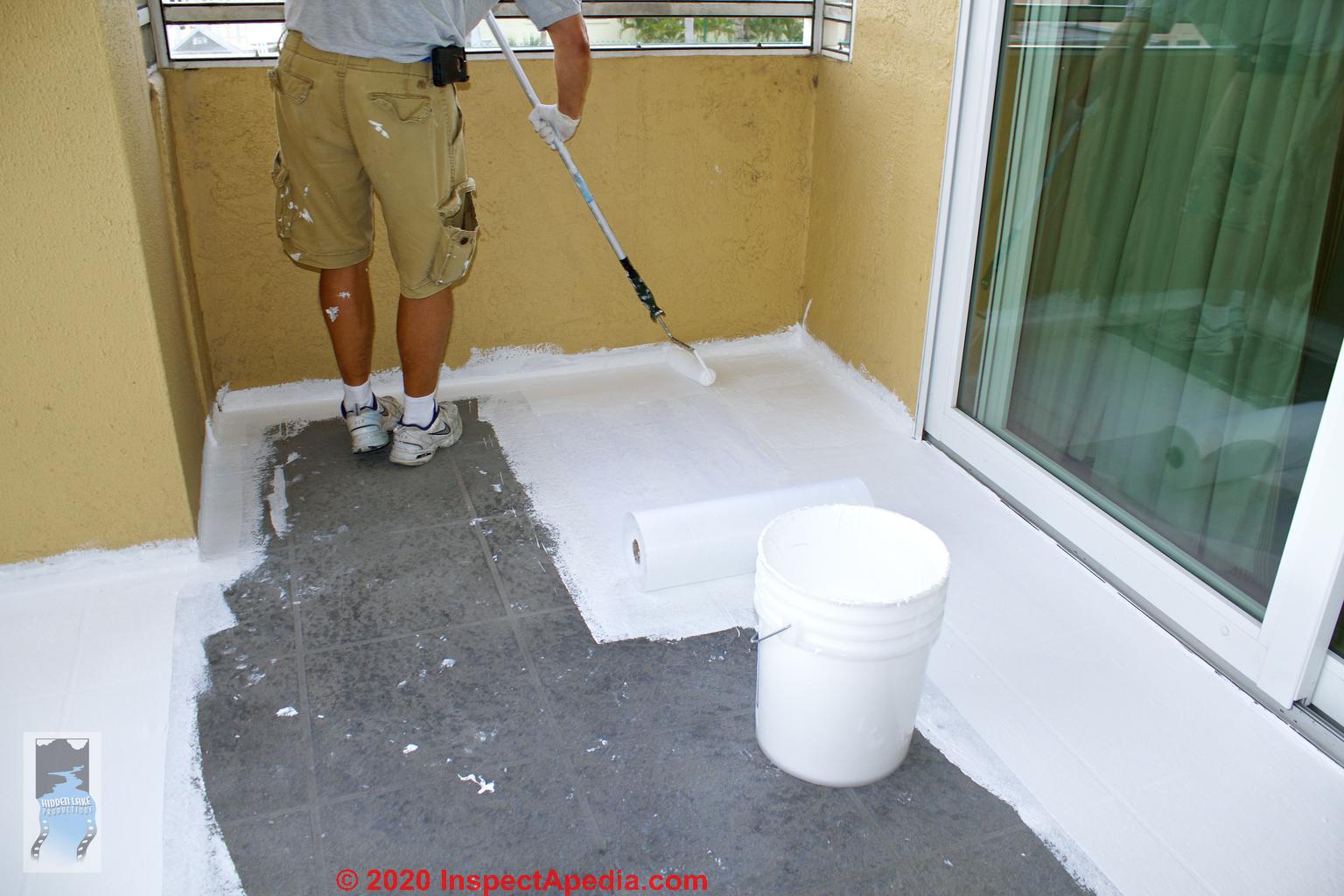 I removed carpet in a 10x12 room, found old vinyl tiles. Some of them are broken at the edges and some are loose.
I removed carpet in a 10x12 room, found old vinyl tiles. Some of them are broken at the edges and some are loose.
I intend to cover with new cork flooring. Before that I'd like to know if I should paint with something like fiber lock 2 or perfect primer, in case of asbestos. Sorry for the long post. Thank you. On 2019-12-1
by John -
Reply by (mod)
John
A typical cover-over job with new floor tiles atop old asbestos-suspect flooring requires that the existing surface be generally smooth and sound - that is, loose tiles are not popping up, and there are no abrupt dips or holes that might telegraph up through the new flooring.
If you're covering with a laminate or engineered wood or wood floor then those small imperfections are unlikely to have any effect whatsoever; you'd just lay down rosin paper or whatever underlayment or vapor barrier the new flooring manufacturer recommends, and proceed.
If you're covering the old floor with sheet vinyl, thin new vinyl floor tiles, or soft cork tiles, you may want to glue down replacement tiles of same thickness of any large sections of tile or flooring that are already missing, OR to use a floor leveling compound.
When your new floor is to be glued or adhered with tile mastic to the old one, the old surface needs to be clean of dust, debris (damp wipe, HEPA vacuum), and clean of any floor wax. I use a liquid stripping compound, NOT any abrasives.
For this type of installation, several of the mold and fire and asbestos abatement coating manufacturers recommend products that bond well to the existing floor and are claimed to accept and bond well to the adhesive used on the new floor.
As we noted on this point in the article above
you may want to see ASBESTOS ENCAPSULANTS & SEALERS - coatings, encapsulants, fiber release control for asbestos containing materialsComment by Jason FIner - Perfect Membrane sealer for asbestos-containing floor tiles or mastic adhesive
John & InspectApedia moderator:
You are correct that the floor must be clean and smooth with loose tiles removed. I have been using perfectprimer for years for these applications. All I do is clean the floor s with someTSP solutions and water. Then apply two coats of perfectprimer.
If you want to apply some leveling agent, like rapid set or thin set etc, then apply it over the first coat perfectprimer, then apply the second coat of the primer over the entire floor and patched area.
Any paint or epoxy or mastic will bind with that and your finished.
If you need to do a full blown encapsulation or waterproofing system, then I use perfect membrane by the same company (Specialty Solutions) - On 2020-02-20
...
Continue reading at ASBESTOS FLOORING LEFT IN PLACE, or select a topic from the closely-related articles below, or see the complete ARTICLE INDEX.
Or see these
Recommended Articles
- ASBESTOS CEMENT PRODUCTS - home
- ASBESTOS FLOORING HAZARD REDUCTION - home
- ASBESTOS FLOORING LEFT IN PLACE - coatings used atop vinyl-asphalt or asphalt-asbestos floor tiles left in place
- ASBESTOS FLOORING REMOVAL GUIDE
- ASBESTOS IDENTIFICATION IN BUILDINGS - home for help in recognizing asbestos-containing materials.
- ASBESTOS LEFT in PLACE in BUILDINGS - MANAGEMENT GUIDES
- ASBESTOS REMOVAL, WETTING GUIDELINES
- ASBESTOS RISK ASSESSMENT
- DOES THIS MATERIAL CONTAIN ASBESTOS? - 5 easy questions to tell if a BUILDING MATERIAL probably contains asbestos -
- FLOOR TILE BASE LEVELING - describes using leveling compounds or filler-tiles before flooring-over asbestos tile floors
- FLOORING ADHESIVE MASTIC SEALANTS - if you need to glue down new floor or add a leveling compound over old tile mastic
- FUNGICIDAL SEALANT USE GUIDE - Additional coatings and sealants used in mold remediation, for dust or mold or other particle control and in other indoor cleanup situations
- MOLD SANITIZER, SPRAY, BIOCIDE USE GUIDE
- POURED-IN-PLACE FLOORING, RESILIENT - pour on a whole new floor surface
Suggested citation for this web page
ASBESTOS ENCAPSULANTS & SEALERS at InspectApedia.com - online encyclopedia of building & environmental inspection, testing, diagnosis, repair, & problem prevention advice.
Or see this
INDEX to RELATED ARTICLES: ARTICLE INDEX to CHIMNEYS & FLUES
Or use the SEARCH BOX found below to Ask a Question or Search InspectApedia
Ask a Question or Search InspectApedia
Try the search box just below, or if you prefer, post a question or comment in the Comments box below and we will respond promptly.
Search the InspectApedia website
Note: appearance of your Comment below may be delayed: if your comment contains an image, photograph, web link, or text that looks to the software as if it might be a web link, your posting will appear after it has been approved by a moderator. Apologies for the delay.
Only one image can be added per comment but you can post as many comments, and therefore images, as you like.
You will not receive a notification when a response to your question has been posted.
Please bookmark this page to make it easy for you to check back for our response.
IF above you see "Comment Form is loading comments..." then COMMENT BOX - countable.ca / bawkbox.com IS NOT WORKING.
In any case you are welcome to send an email directly to us at InspectApedia.com at editor@inspectApedia.com
We'll reply to you directly. Please help us help you by noting, in your email, the URL of the InspectApedia page where you wanted to comment.
Citations & References
In addition to any citations in the article above, a full list is available on request.
- Roger Hankey is principal of Hankey and Brown home inspectors, Eden Prairie, MN. Mr. Hankey is a past chairman of the ASHI Technical Committee and the ASHI Standards Committee. Mr. Hankey serves as co-chairman of ASHI legislative committee, and has served in other ASHI professional and leadership roles. Contact: 952 829-0044 - hankeybrown@comcast.net
- Ervin McKinney, a gas industry expert in Lorain OH, kindly provided this PDF copy of 1948/1949 Underwriters Laboratories UL List of Inspected Gas, Oil, and Miscellaneous Appliances. October 2010
- ASBESTOS IN YOUR HOME U.S. EPA, Exposure Evaluation Division, Office of Toxic Substances, Office of Pesticides and Toxic Substances, U.S. Environmental Protection Agency, Washington,D.C. 20460
- "Handling Asbestos-Containing roofing material - an update", Carl Good, NRCA Associate Executive Director, Professional Roofing, February 1992, p. 38-43
- EPA Guidance for Controlling Asbestos-Containing Materials in buildings, NIAST, National Institute on Abatement Sciences & Technology, [republishing EPA public documents] 1985 ed., Exposure Evaluation Division, Office of Toxic Substances, Office of Pesticides and Toxic Substances, U.S. Environmental Protection Agency, Washington,D.C. 20460
- In addition to citations & references found in this article, see the research citations given at the end of the related articles found at our suggested
CONTINUE READING or RECOMMENDED ARTICLES.
- Carson, Dunlop & Associates Ltd., 120 Carlton Street Suite 407, Toronto ON M5A 4K2. Tel: (416) 964-9415 1-800-268-7070 Email: info@carsondunlop.com. Alan Carson is a past president of ASHI, the American Society of Home Inspectors.
Thanks to Alan Carson and Bob Dunlop, for permission for InspectAPedia to use text excerpts from The HOME REFERENCE BOOK - the Encyclopedia of Homes and to use illustrations from The ILLUSTRATED HOME .
Carson Dunlop Associates provides extensive home inspection education and report writing material. In gratitude we provide links to tsome Carson Dunlop Associates products and services.


